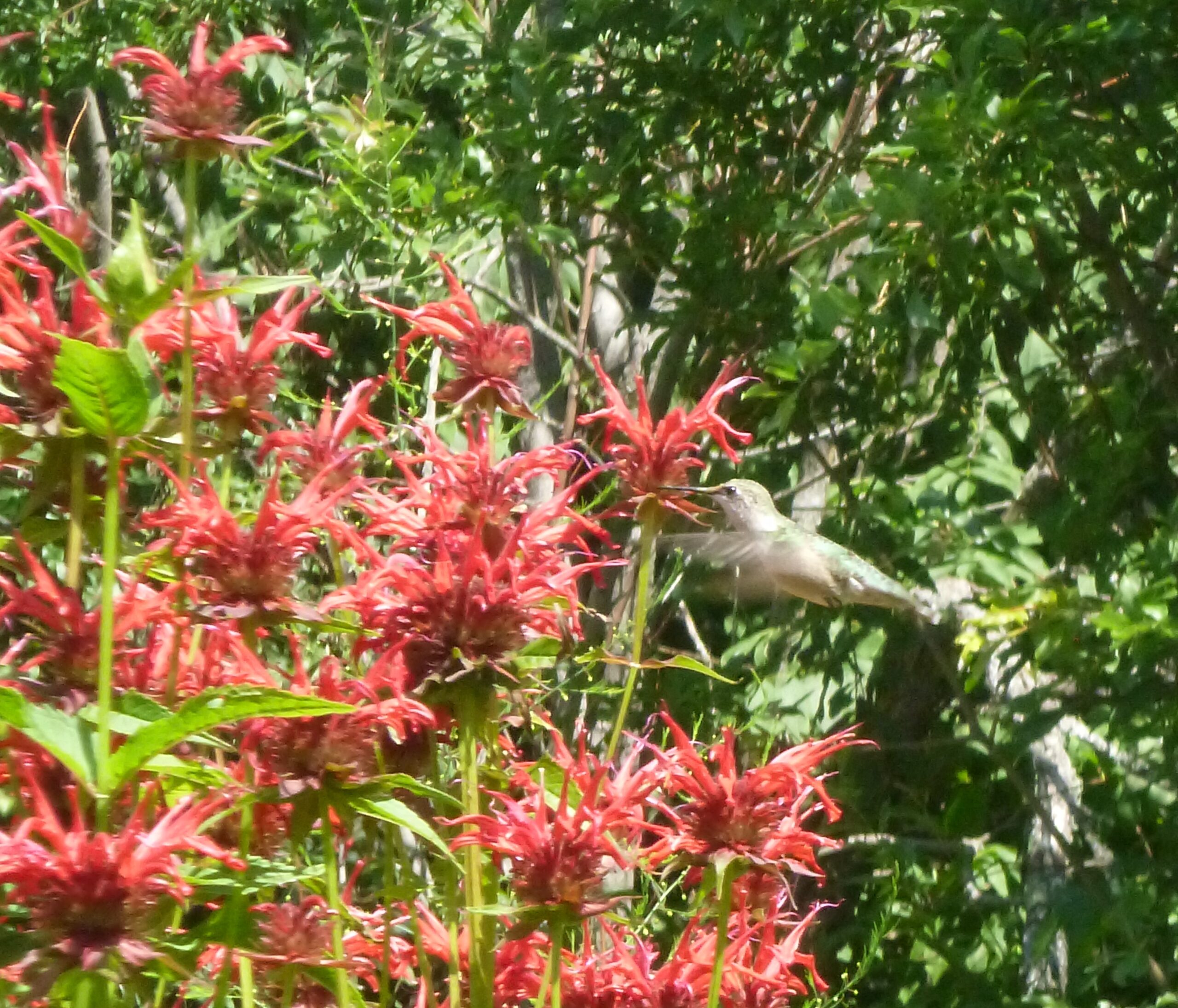
“Nibi Chronicles,” a monthly Great Lakes Now feature, is written by Staci Lola Drouillard. A direct descendant of the Grand Portage Band of Ojibwe, she lives and works in Grand Marais on Minnesota’s North Shore of Lake Superior. Her two books “Walking the Old Road: A People’s History of Chippewa City and the Grand Marais Anishinaabe” and “Seven Aunts” were published 2019 and 2022, and she is at work on a children’s story. “Nibi” is a word for water in Ojibwe, and these features explore the intersection of Indigenous history and culture in the modern-day Great Lakes region.
My mother maintains that ruby-throated hummingbirds return to Lake Superior on May 10, which often corresponds with Mother’s Day or the inland fishing opener, depending on what your priorities are. I have inherited her admiration for these tiny, and yet mighty birds, who can travel 20 hours a day and fly 500 miles before needing to rest. When my parents lived in Grand Portage, they would anxiously await the spring return, with feeders full and hung in trees and on poles along their deck. The house was close to the shoreline, and right on the bird’s migration route, if not a prime destination.
According to North Shore phenologist Chel Anderson, the woods of Northeastern Minnesota are at the heart of a richly diverse area of forested lands that offer birds everything they need for a successful breeding season. That’s why these tiny birds make the long trip every year. On those early spring days after the hummingbirds’ return, it was common for mom to fill multiple feeders every day to keep up with the demand.
Most of what I know about nenookaasiwag — hummingbirds, comes from our former neighbor and resident bird expert Molly Hoffman, who has left this earthly world, but whose wisdom continues to inform bird watchers via her radio series Field Notes. When Molly would impart a nugget of bird knowledge, it tended to stay front of mind — just one of her many gifts. It was Molly who made my partner promise to always keep cats indoors, explaining that domestic cats kill billions of birds every year.
It’s a promise we’ve kept over the years, and it’s nice to know that we’re doing our small part to keep the neighborhood birds safe. When I was a burgeoning hummingbird newbie, Molly laid out some specific rules to ensure that we would help, and not hurt our seasonal visitors. She sternly warned that “one must change out the nectar every few days and be very diligent about cleaning the feeders at least once a week.” That includes the inner workings of the feeder which need to be cleared of muck with a pipe cleaner. I now keep an old toothbrush handy to reach deep inside the glass nectar jar, making sure that any black residue is scrubbed and rinsed away.
Molly was also a stickler about bringing feeders inside on cold nights, explaining that a high sugar content keeps the nectar from freezing, even though the liquid is below 31 degrees. When a hummingbird drinks liquid so far below its own body temperature, it can’t metabolize it fast enough and it will send it into hypothermic shock, causing heart failure and certain death.

Bezhigo nenookaasi (one hummingbird), Good Harbor Hill. (Photo Credit: Staci Lola Drouillard)
Based on Molly’s deep knowledge of boreal birds, we also know that the return of nenookaasiwag coincides with the return of yellow-bellied sapsuckers, who drill holes in trees to draw out sap, which in turn attract insects — two early food sources for both bird species. This reciprocal relationship helps to tide them over until wildflowers and trees begin to bloom. In fact, those annoying blackflies and mosquitos — zaagimewag, are the main draw for 61 to 67 species of birds, the highest number of bird species found north of the Mexican rainforests.
A little adds up to a lot
Of course, the striking characteristics and abilities of nenookaasiwag carry many teachings for human beings. In one Ojibwe story it is who comes to the rescue of all, when a massive wildfire threatens Anishinaabe Aki. The brave, little hummingbird flies to a nearby lake and fills its beak with water, dropping it one, tiny drop at a time to extinguish the flames. At first admonished for being too small and ineffective, the stalwart bird continued its mission, and soon all the animals were inspired to pitch in and do their part, until the flames were snuffed out.
The lesson imparted by the slow and steady approach of Nenookaasi is that even though it seems like we are too small to make a difference, our small and deliberate actions add up to a bigger, and more consequential outcome. As a writer who worries whether my own small expressions of study and concern will ever make a difference, I look to Nenookaasi as a model of resilience and determination to keep going, even if it seems futile at times.
In the story of the wildfire The Creator observes the bravery of little Nenookaasi and rewards the bird with the gift of speed and dexterity. Indeed, hummingbirds can fly backwards, forwards and sideways — their wings able to reach 80 beats per second. They weigh less than a nickel and can shake rain from their bodies while hovering in mid-air to rid themselves of extra weight, which might slow other birds down or keep them from feeding in the rain.
Most anyone who is touched by the presence of hummingbirds has a good story about a close encounter. Last summer I was foraging for kinnikinnik on Saganaga Lake — a blend of medicines that grow together where the water is clean and the forest is mostly undisturbed. I was hesitant to collect some cedar that was growing close to the water and had paused, asking for permission to harvest just a few sprigs. At that exact moment, I heard the buzz of nenookaasi wings beating and there she was, diligently working the mix of cedar, sweet gale and other shoreline plants for nectar. This little bird was far away from the world of humans and yet had everything that it needed.
Even though Nenookaasiwag don’t require human help to feed themselves, I do feel a responsibility to share Molly’s hummingbird wisdom with others, so that people are aware that taking care and doing the little things to make your yard bird-friendly could make a big difference in the lives of hummingbirds and other species. In addition to following Molly’s advice about cats and caring for feeders, we’ve also planted perennials like bee balm, hollyhock, coneflower and anise hyssop in the garden — and strictly avoid using any kind of chemicals or herbicides. May 10 is fast approaching so I’ve already located and cleaned our feeders, and patiently await the reliable return of the mighty Nenookaasiwag.
Catch more news at Great Lakes Now:
Nibi Chronicles: The nation-to-nation fight against extractivism
Not Just Pretty Pictures: Bearing witness to the night sky
Featured image: Bee balm, a favorite of bees and hummingbirds. (Photo Credit: Staci Lola Drouillard)




